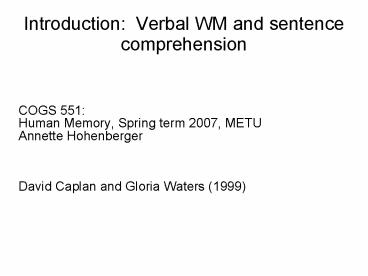Introduction: Verbal WM and sentence comprehension - PowerPoint PPT Presentation
1 / 14
Title:
Introduction: Verbal WM and sentence comprehension
Description:
Introduction: Verbal WM and sentence comprehension. COGS 551: ... Boy [boy hugged girl] kissed baby. Obj-Rel-Clauses: ... The boy hugged the girl and kissed the baby ... – PowerPoint PPT presentation
Number of Views:41
Avg rating:3.0/5.0
Title: Introduction: Verbal WM and sentence comprehension
1
Introduction Verbal WM and sentence
comprehension
- COGS 551
- Human Memory, Spring term 2007, METU
- Annette Hohenberger
- David Caplan and Gloria Waters (1999)?
2
Verbal Working Memory
Caplan Waters Is there a further
fractioniation of the verbal working memory for
sentence comprehension?
- Logie_Lecture_Notes
- psy-www-old.psy.ed.ac.uk/Local/Lectures/Psych3blog
ie/Level3Lecture8.ppt -
3
2 types of verbal WM
- Interpretive processing
- ?parsing
- (lat pars piece)?
- Recognizing words, their meanings and syntactic
properties - building up syntactic and prosodic
representations - assigning thematic roles
- Postinterpretive processing
- Storage of verbal info in LT semantic M,
reasoning, planning actions
Since parsing is an autonomous process, in the
view of modularists (Fodor, Frazier, Forster,
Garrett), the idea is to also grant it a separate
verbal WM component
Parsing is a reflex (Garrett)?
4
Sentence comprehension and WM
- Certain S structures are harder to parse than
others, e.g. Center embedded S - The man that the woman that the child hugged
kissed laughed - The child hugged the woman
- The woman kissed the man
- The man laughed
- All theories of parsing assume that complex
sentences such as center-embedded S's require
more WM resources. - Parsing time is a function of S complexity.
- In experiments, duration of eye fixation,
duration of self-paced word-by-word reading,
lexical decision time increase when parsing
complex Ss.
5
Interpretive processes require WM
- Increased demands on interpretive processes
- Subj-Rel-Clauses
- The boy that hugged the girlSubj-Rel kissed the
baby - Boy boy hugged girl kissed baby
- Obj-Rel-Clauses
- The boy that the girl huggedObj-Rel kissed the
baby - Boy girl hugged boy kissed the baby
- Obj-Rel-Clause is harder to parse. Why?
6
Post-interpretive processes require WM
- Increased demands on post-interpretive processes
- Clause with one proposition
- The boy hugged the girl and the baby
- Clause with two propositions
- The boy hugged the girl and kissed the baby
- The clause containing two pospositions is harder
to process than the one with just one
proposition. This increasing demand, however, is
qualitatively different from the one between
differently complex syntactic clauses (previous
slide). It affects post-interpretive processes,
e.g., storage in LTM. - How are the two demands different?
7
The two hypotheses
- Single resource theory, SR
- There is just one WM for all verbal tasks
- Just Carpenter 1992 MacDonald et al. 1992,
Miyake et al. 1994?
- Separate sentence interpretation resource, SSIR
- There is a special verbal WM component just for
parsing - Caplan and Waters
8
S comprehension and WM in normal subjects two
different methods
- Individual differences in WM span and parsing
- High-span and low-span subjects process simple
vs. complex sentences
- Mutual interference between two tasks WM task
and parsing - (Unselected) Subjects are tested on two
concurrent tasks, one requiring general verbal
WM, one requiring interpretive parsing
9
Predictions of the two accounts
- 1. Method
- Individual differences in WM span and parsing
- High-span and low-span subjects process simple
vs. complex sentences - SR predicts an interaction both groups should
differ only in the complex condition since it is
there where the shortage of the common verbal WM
resource becomes critical - SSIR predicts no such interaction both groups
should not differ since despite different verbal
WM spans, there is a different resource pool just
for parsing which is unaffected by WM span. So
even if there is a shortage of verbal WM
resources in low-span subjects, this does not
affect their performance
10
Predictions of the two accounts
- 2. Method
- Mutual interference between two tasks WM task
and parsing - SR The concurrent verbal WM task should
interfere with parsing, since both tasks draw on
the same WM resource. - SSIR The concurrent verbal WM task should NOT
interfere with parsing.
11
No compelling evidence against SSIR from this
method
- Caplan and Waters (1999) doubt that there is
compelling evidence for the Single Resource SR
account. - The fact that low-span subjects can remember less
words in a self-paced reading-span task does not
have to be due to weaker WM but may be due to
less effective allocation of attention . In this
case, the difference between the groups may still
be compatible with SSIR
12
Combination of both methods
- Low- and high-span subjects perform 2 concurrent
tasks 1 for verbal WM and one for parsing
(simple vs. complex S) - Predictions
- SR predicts a 3-way interaction Impairment of
low span subjects on complex S's is exacerbated
(espacially worse) by concurrent load. - SSIR predicts no such 3-way interaction Low-span
subjects do less well on the task overall, but
not differentially worse on complex S's.
13
- ??The study of Fedoreko, Gibson, and Rohde (2006)
tests a similar prediction - ??Next presentation
14
References
- Caplan, D. and Waters, G. (1999) Verbal working
memory and sentence comprehension. Behavioral and
Brain Sciences 22, 77-126. - Fedorenko, E., Gibson, E.,and Rohde, D. (2006)
The nature of working memory capacity in sentence
comprehension Evidence against domain-specific
memory resources. Journal of Memory and Language,
54, 541-553. - Just, M.A. and Carpenter, P.A. (1992) A capacity
theory of comprehension Individual differences
in working memory. Psychological Review, 99,
122-149. - MacDonald, M. C., Just, M. A., Carpenter, P. A.
(1992). Working memory constraints on the
processing of syntactic ambiguity. Cognitive
Psychology, 24, 56-98. - Miyake, A., Carpenter, P., Just, M. (1994). A
capacity approach to syntactic comprehension
disorders Making normal adults perform like
aphasic patients. Cognitive Neuropsychology, 11,
671-717.































